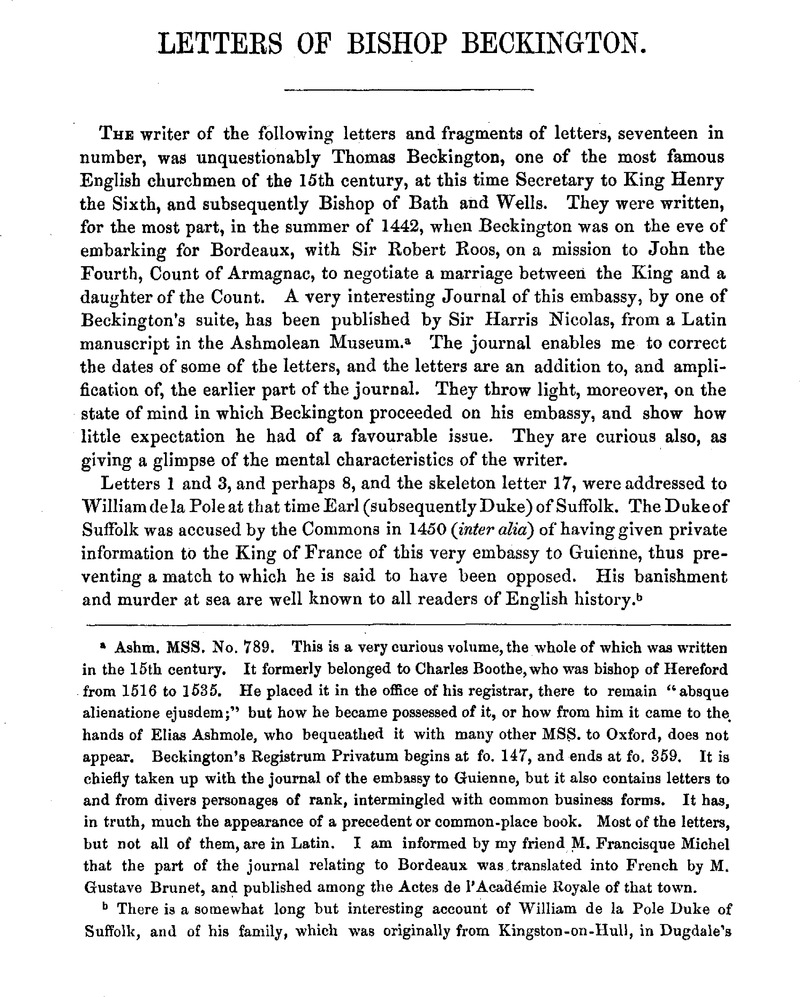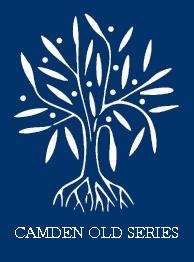No CrossRef data available.
Article contents
Letters of Bishop Beckington
Published online by Cambridge University Press: 23 February 2010
Abstract

- Type
- Letters of Bishop Beckington
- Information
- Copyright
- Copyright © Royal Historical Society 1863
References
page 71 note a Ashm. MSS. No. 789. This is a very curious volume, the whole of which was written in the 15th century. It formerly belonged to Charles Boothe,who was bishop of Hereford from 1516 to 1535. He placed it in the office of his registrar, there to remain “absque alienatione ejusdem;” but how he became possessed of it, or how from him it came to the hands of Elias Ashmole, who bequeathed it with many other MSS. to Oxford, does not appear. Beckington's Registrum Privatum begins at fo. 147, and ends at fo. 359. It is chiefly taken up with the journal of the embassy to Guienne, but it also contains letters to and from divers personages of rank, intermingled with common business forms. It has, in truth, much the appearance of a precedent or common-place book. Most of the letters, but not all of them, are in Latin. I am informed by my friend M. Francisque Michel that the part of the journal relating to Bordeaux was translated into French by M. Gustave Brunet, and published among the Actes de l'Académie Royale of that town.
page 71 note b There is a somewhat long but interesting account of William de la Pole Duke of Suffolk, and of his family, which was originally from Kingston-on-Hull, in Dugdale's Baronage, vol. ii. p. 180 to 189. See a note to Letter ix. of the Paston Letters, vol. i. p. 33. See also Index to Journal, p. 127. He married Alice, daughter and heir of Thomas Chaucer (son of the poet), who had been first married to Sir John Phelip, knight, and secondly to Thomas de Montacute, Earl of Salisbury, who was killed at Orleans in November, 1428. She survived all her husbands, and died 9 June, 1475 (15 Edw. IV.), and is buried at Ewelm. These letters throw no light on the question whether Suffolk really gave information to Charles VII. respecting this embassy. See Journal, xlvi. xlvii. xlviii. They show, however, that the ambassador was in intimate communication with the earl, up to the time of his own departure for Guienne.
page 72 note a Harl. MSS. No. 6952, fo. 135. The old rectory-house, then a private residence, was standing in 1813. Some of the old windows still remained. (Lysons' Berks, p. 213.)
page 72 note b The MS. says the 20th day of June; but I believe this to be a mistake of the copyist. (Journal, p. 1.)
page 72 note c Letter 1.
page 72 note d The MS. says “xviii. June;” but this is clearly a mistake.
page 72 note e Journal, p. 2.
page 72 note f There was another John Norreys, of whom William of Worcester records that he was attainted of treason and hanged at Tyburn, 7 Edw. IV., 1467. (Lib. Nig. Scacc. vol. ii. p. 516, Hearne's edition.)
page 73 note a Dugd. Bar. vol. ii. p. 245; Banks, Dorm, and Ext. Bar. vol. ii. p. 471.
page 73 note b Journal, p. 2.
page 73 note c Ibid.
page 73 note d Sir Edmund Hungerford resided at Down Ampney, an estate on the borders of Wilts and Gloucester, not far from Cricklade, settled on him by his father. Of his mansion here there is still remaining a handsome gateway flanked with turrets. Sir Edmund Hungerford died in 1484 (Hungerfordiana, pp. 14, 102, 103; Wiltshire Collections, 4to, 1862, p. 411.)
page 73 note e Journal, p. 2.
page 73 note f Journal, p. 2.
page 73 note g Supra, p. 35, note g.
page 74 note a Hungerfordiana, , pp. 8, 14.Google Scholar
page 74 note b Ibid. 10. The summons to Parliament, in 1445, was three years later than the letter. But, as, in the letter, Lord Hungerford's grandson is called Lord Moleyns, it would seem that he bore that title from the time of his marriage. Robert second Lord Hungerford adhered faithfully to the House of Lancaster. He died in 1458, and was buried in Salisbury cathedral. His widow Margaret, daughter and heir to William Lord Botreaux, survived until 1477: this lady founded Hungerford Chapel in Salisbury cathedral, which has vanished. She, too, was buried there. The third Lord Hungerford (Lord Moleyns) deemed it prudent to side with the House of York, but afterwards endeavouring, in 1463, to restore Henry VI, he was tried and executed. He was buried “with his fathers.” His wife, who survived him, and married Sir Oliver Manningham, knight, was buried at Stoke Poges in Bucks. From them are descended, through a daughter, the Earl of Huntingdon and the Marquis of Hastings. (Hung. pp. 10, 38.)
page 74 note c Fasti Eec. Ang. vol. ii. p. 603; Wiltshire Collections, 4to. 1862, p. 351.
page 74 note d Journal, p. 2.
page 74 note e Ibid.
page 74 note f Ibid.
page 74 note g Ibid.
page 74 note h Ibid.
page 75 note a Journal, p. 5.
page 75 note b Ibid. pp. 5 and 5.
page 75 note c Ibid. p. 3.
page 75 note d Ibid. p. 3.
page 75 note e Ibid.
page 75 note f Ibid.
page 75 note g He was sent as ambassador to France, and also to the Pope, by Henry the Sixth. (Harl. MSS. No. 6963, fo. 91.) Vincentius or Vincent Clement is repeatedly mentioned in the Collection of Beckington's Letters, which is in the Archbishop's library at Lambeth. He is also frequently mentioned in Beckington's Registrum Privatum, at the Bodleian.
page 75 note h Pope Eugenius IV., in a letter of 28 May, 1442, calls Vincent Clement “mhdiaconus motter.” (Reg. Priv. fo. 167.) The King adopts this title (Lamb. MS, fo. 82), but calls him his “nuncius” (ibid. fo. 52, tergo), and his “faithful and beloved orator” ibid. fo. 82). He also says that he was brought up and educated at Oxford (ibid. fo. 80). Gas coigne says he was called “the unwonted doctor” (doctorem insolentem) because his degree of D.D. was conferred, when he was only in deacon's or subdeacon's orders, by royal mandate. (Dict. Theol. and see Life of Pecock, p. 14.) Archbishop Parker certainly thought he was an Italian. He calls him “quidam Romanus. (Parkeri Antiq. p. 434.)
page 76 note a The Bull is to be found in Huggett's MS. Hist, of Eton, vol. ii. p. 171. (Sloane MSS. No. 4840.)
page 76 note b He appears to have met with impediments, for there exists a letter addressed to him (by Beckington, as I conceive) exhorting him to prosecute his mission “with manly courage” (virili animo), and plying him with arguments, which appear to be drawn from Ovid's Trislia. (Lamb. MS. fo. 52 tergo.)
page 76 note c His preferments were as follows: Rector of St. Martin's Vintry from 1439 to 1444 (Newc. Rep. vol. i. p. 422), Prebendary of Hereford in 1451 (Fasti E. A. vol. i. p. 526), Prebendary of Lincoln 1452 (F.E.A. vol. ii. pp. 214, 234), Archdeacon of Wilts 1457–8 (Ibid. vol. ii. p. 630), Prebendary, Chancellor, and Treasurer of Lichfield (Ibid., vol. i. pp. 582, 584, 630), Archdeacon of Huntingdon (Ibid. vol. ii. p. 51), and Archdeacon of Winchester (Ibid. vol. iii. p. 26).
page 76 note d I have tried in vain to identify this John Somerset. I have examined all the authorities cited by Sir Harris Nicolas (Journal, p. 126), and many not cited by him, and am utterly unable to decide, whether he was a layman or an ecclesiastic. Thomas Baker, in his letters to Hearne, (Appendix to Elmham's Life of Henry the Fifth, p. 350) certainly supposed John Somerset, the King's physician, and Chancellor of the Exchequer, to have been a layman. Beckington's friend was a married man (Journal, p. 95). Nevertheless John Somerset is described seven several times in the fifth volume of the Rolls of Parliament as a “clerk.” The evidence is so contradictory that I am driven to suppose that there were two persons of the same name, living at the same time, and both employed about public affairs.


